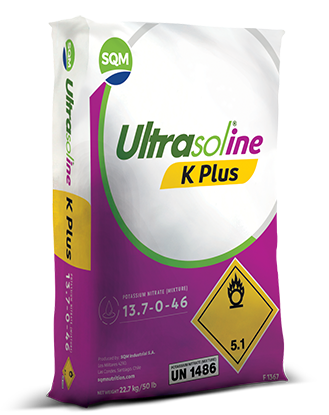Iodine (I) should be considered as a plant nutrient. That is the main conclusion of Kiferle et al., 2021. In that paper, the presence and identity of naturally occurring iodinated proteins in higher plants, which had never been described before, was published. At least 82 iodinated proteins have been identified that take part in important biological processes in higher plants. Similar to deficiency in any other plant nutrient, a deficiency in iodine is predicted to cause yield losses.
In fertigated and protected horticultural crops, grown in a commercial production setting, iodine deficiency can occur when the presence of iodine in the nutrient solution is below a sufficiency target value. In intensive, fertigated cropping systems under cover or in arid regions, the nutrient solution and irrigation water are the main sources of iodine. This deficiency will be visible as sub-optimal root or leaf development, later flowering, lower fruit growth and lower resilience to stress, resulting in lower yields compared to a crop which has been supplied with sufficient iodine in the nutrient solution.
42 proteins in the leaf can bind iodine. The majority of these proteins are located in the chloroplasts, which convert sunlight into the chemical energy that is needed to produce carbohydrates from CO2. The plants need carbohydrates to fuel their own growth, to maintain the functions of the root system, and to fill the fruits with a higher content of soluble sugars (measured as degrees Brix). When sugar production is inhibited, e.g. by environmental stress, less sugars will be transported to the fruits. But of course, degrees Brix are a top priority for the berry grower who wants to distinguish his produce with the best taste. The presence of iodinated proteins in photosynthesis improves sugar production and helps growers to achieve the size of fruits and degrees of Brix, required by a demanding market.
By improving the whole plant growth, the use of Ultrasol®ine K Plus in the nutrient solution can increase the concentration of calcium in fruits, compared to a control where potassium nitrate without iodine is applied. Translocation of calcium to fruits is the result of many biological processes and may be related to a better root system, a well-tuned photosynthesis and control of transpiration by opening or closing of stomata in response to the weather conditions, all resulting in uniform fruit growth despite variations in climate. Also important is the maintenance of a good balance between the cations K+, Ca++ and Mg++, NH4+ and the anion NO3- in the nutrient solution, and low sodium (Na+) levels in the water.
The management of energy in the roots is crucial. It depends on the production of chemical energy from sugars in the roots, and is needed for the transport of nutrients from the roots to the upper parts of the plant. Iodine is important for the growth and function of the roots. It is present in 40 iodinated proteins with function in the energy metabolism and defense from oxidative stress in the root system. In demonstration trials with growers, it is shown that use of Ultrasol®ine K Plus as source of potassium, nitric nitrogen and iodine, can result in higher calcium concentrations in the fruits, and can help growers to prevent calcium-related disorders such as blossom end rot. It can also reduce the incidence of rot during shelf-life of the fruits.
Fruit size and degrees Brix in soft fruits like blueberry and raspberry are important for the grower. A bigger fruit size saves labour because less fruits are needed to fill one unit of sales, and more degrees Brix makes the fruits more appealing for customers because of the improved taste. As an example, four trials are described here that demonstrate the benefit of application of Ultrasol®ine K Plus as source of potassium nitrate in the nutrient solution, following the normal farm practice. Table 1 gives some details of these on-farm demonstration trials: two trials in Mexico, on blueberry and raspberry, one trial in Peru on blueberry, and one in Morocco, on raspberry.
The trials were carried out under guidance of Edgar De La Cruz, SQM-Vitas Perú, Jesus Andrey Gonzalez, SQM Mexico, and the agronomists of the berry-production facility in Morocco.
In general, the potassium concentration in the nutrient solution for berries aims at 3-6 mmol K/L, increasing from 3 mmol/L in the vegetative schedule, to 6 mmol/L in the production schedule. This results in 2.5-5 micromole of total iodine (I) per liter, when all potassium is applied with Ultrasol®ine. In contrast, iodine is present in very low concentrations, in the nutrient solution when Ultrasol®ine is not applied. In that case, iodine concentration in the irrigation water is low. Low levels of natively occurring iodine in the water were measured at the locations of blueberries in Mexico (0.02 micromole/L) and the raspberries in Morocco (0.3 micromole/L). In Peru iodine in well water of 5 different production locations in Ica and Chincha was sampled, and contained on average only 0.3 micromole I/L (in a range of 0.05-0.6 micromole/L).
Table 1. Application amounts and frequency of potassium nitrate application in the farmers nutrient solution

In Perú, the use of Ultrasol®ine in the nutrient solution for blueberry production of cultivar Kirra in organic substrate, resulted in an increase of yield of 13%, when potassium nitrate plus iodine was used instead of normal potassium nitrate in the control. More berries were found in the size-class larger than 19 mm (Figure 1). In the same blueberry cultivar Kirra, grown in soil, yield increased from 27 MT/ha in the control, to 38 MT/ha with Ultrasol®ine, an increase of 39%. Also in the other soil-grown cultivars Biloxi and Terrapin, +30% resp. +5% higher yields were recorded. Additional trials on blueberry var. Biloxi were performed In Mexico. Increase in total yield was not recorded, but the grower noticed a better condition of the crop, and a more concentrated flower flush, resulting in a shorter period needed for the fruit harvest. Additionally, the berries had a higher brix, and a higher concentration of calcium in the fruits was analysed (Figure 2).
During the trials in raspberry, on both locations the farmers noticed a better root system, with a stronger development of new, white roots in the sectors where Ultrasol®ine was applied. The total fruit yield in Mexico, was improved by 10% as a result of heavier fruits, so less fruits are needed to fill one sales unit (a clam shell of 197 gram/shell) (Figure 3). In Morocco, +10% more raspberries were harvested on a crop from the first year planting, with a higher concentration of calcium in these fruits. Additionally, the grower noticed a better flush of new canes, preparing for the next season’s yield, compared to the control sector which suffered from rooting problems (Figure 4).

Peru- Blueberry var. Kirra in cocopear substrate with Ultrasol®ine, + 13% more yield was recorded, with relatuvely more berries in the largest size class

Peru- Blueberry 3 trials in soil grown cultivars with Ultrasol®ine, consistent increase in total season yield in var. Kirra, Biloxi and Terrapin

Figure 1. Percentage of berries with a diameter in one of three size classes of the trial in blueberry (var. Kirra, substrate grown), Peru. With Ultrasol®ine 13% more yield was recorded, with relatively more berries in the size class larger than 19 mm diameter. In 3 trials in soil-grown berries, a consistent improvement of yield was observed for 3 different cultivars.

Figure 2. Improved sugar content and calcium concentration in the blueberry fruits from the trial in Mexico.


Figure 3. Mexico, raspberry. The moderate increase in fruit size, resulted in 10% more units of sale (clam shells) when Ultrasol®ine was used. More new white roots were observed in the plants receiving Ultrasol®ine.

Figure 4. 8% more yield in soil grown raspberries in Morocco. These fruits contained more calcium when Ultrasol®ine was the potassium nitrate source in their nutrient solution. Note the growth of the new canes for next season’s yield, which developed more strongly compared to the control sector.




